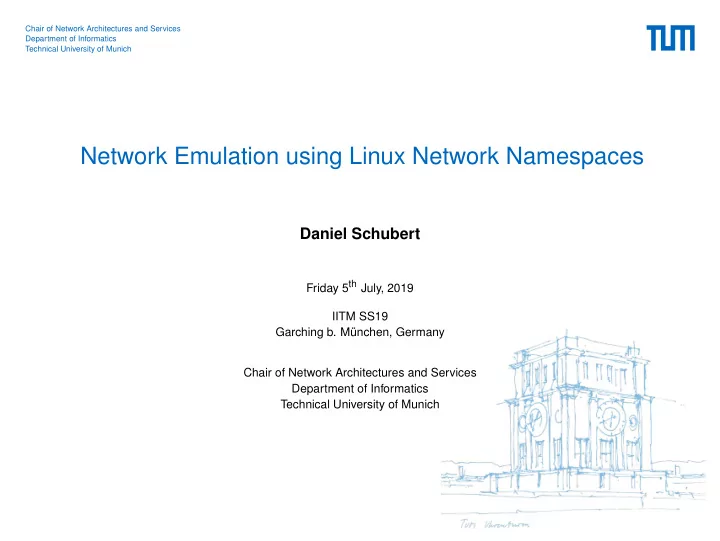

Chair of Network Architectures and Services Department of Informatics Technical University of Munich Network Emulation using Linux Network Namespaces Daniel Schubert Friday 5 th July, 2019 IITM SS19 Garching b. München, Germany Chair of Network Architectures and Services Department of Informatics Technical University of Munich
Agenda • Options for Network Testing • Linux lightweight emulation features • Mininet • Conclusion D. Schubert — Network Emulation using Linux Network Namespaces 2
Introduction Options for Network Testing Hardware Testbed Simulator Emulator accurate inexpensive inexpensive hard to recon fi gure fl exible fl exible expensive might be unrealis � c real code D. Schubert — Network Emulation using Linux Network Namespaces 3
Introduction Hardware Testbed Hardware Switch Switch tap0 tap1 eth0 eth0 Host Host Hardware Host Hardware Host D. Schubert — Network Emulation using Linux Network Namespaces 4
Introduction Network Emulation Hardware Host v Switch tap0 tap1 eth0 eth0 Host Host Virtual machine Virtual machine D. Schubert — Network Emulation using Linux Network Namespaces 5
Introduction Network Emulation Hardware Host Switch veth0 veth1 Virtual Ethernet pairs eth0 eth0 Host Host Network Namespace Network Namespace D. Schubert — Network Emulation using Linux Network Namespaces 6
Linux Emulation Features Namespaces • Isolate one or serveral processes • Own view of system resource • Examples: • Mount Namespace • PID Namespace • Network Namespace D. Schubert — Network Emulation using Linux Network Namespaces 7
Linux Emulation Features Network Namespaces • Individual copy of network stack per namespace • Network devices • Routing tables • Ports ... • • Creation • ip netns add <name> • ip netns exec <name> <command> D. Schubert — Network Emulation using Linux Network Namespaces 8
Linux Emulation Features Network Namespaces • Individual copy of network stack per namespace • Network devices • Routing tables • Ports ... • • Creation • ip netns add <name> • ip netns exec <name> <command> Virtual Ethernet Devices • Always created as interconnected pairs • Acts as tunnel connecting two namespaces • Creation: • ip link add <d1> type veth peer name <d2> • ip link set <d2> netns <d2-namespace> D. Schubert — Network Emulation using Linux Network Namespaces 8
Linux Emulation Features Control Groups • Limit resources for group of processes • Used to emulate CPU limited Hosts D. Schubert — Network Emulation using Linux Network Namespaces 9
Linux Emulation Features Control Groups • Limit resources for group of processes • Used to emulate CPU limited Hosts Linux Traffic Control (tc) • Configure Traffic Control of Linux kernel • Influence how packets are handled at specific interfaces • Used to emulate links with lower bandwidth or delay D. Schubert — Network Emulation using Linux Network Namespaces 9
Linux Emulation Features Creating Emulation Manually 1 1 From [1] D. Schubert — Network Emulation using Linux Network Namespaces 10
Mininet Overview • CLI and API to create and interact with network • Open source project written in Python • Emulation is performed by C-code • Developped as a tool for rapid prototyping of SDNs D. Schubert — Network Emulation using Linux Network Namespaces 11
Mininet Create Emulation with Mininet API 2 2 From [1] D. Schubert — Network Emulation using Linux Network Namespaces 12
Mininet Create Emulation with Mininet API 3 3 From [1] D. Schubert — Network Emulation using Linux Network Namespaces 13
Mininet Create Emulation with Mininet API 4 4 From [1] D. Schubert — Network Emulation using Linux Network Namespaces 14
Mininet Performance Host 1 Host 1 Host 2 Host 2 Switch v Switch v Switch v Switch v Host N Hosts (N) 1 100 500 1000 Switches (N) 1 100 500 1000 Setup (s) 0.103 ± 0.005 0.652 ± 0.033 3.32 ± 0.166 7.06 ± 0.353 Setup (s) 0.104 ± 0.005 5.47 ± 0.273 185.5 ± 9.276 230.95 ± 15.70 RAM (MB) 396 ± 9.17 438 ± 30.52 941 ± 19.49 1570 ± 155.77 RAM (MB) 308 ± 12.17 433 ± 54.41 961 ± 51.43 1737 ± 158.41 NRFR (%) 0.0 0.0 0.0 30.91 NRFR (%) 0.0 0.0 65.08 85.48 [2] D. Schubert — Network Emulation using Linux Network Namespaces 15
Mininet Pros • Fast Setup of Networks • Use real programs on Network Nodes • Runs on a single laptop • Easy to install (included with Ubuntu 12.10) • Easy to use with CLI and Python scripts • Open source • Under active development D. Schubert — Network Emulation using Linux Network Namespaces 16
Mininet Pros • Fast Setup of Networks • Use real programs on Network Nodes • Runs on a single laptop • Easy to install (included with Ubuntu 12.10) • Easy to use with CLI and Python scripts • Open source • Under active development Cons • Resource limits • Only with Linux kernel • By default all hosts share file system and PID space • No timing guarantees • No virtual time D. Schubert — Network Emulation using Linux Network Namespaces 16
Mininet Related Work • ns-3: open source discret-event simulator • Mahimahi: record-and-replay network emulator • Mininet clustering: Split network topology between multiple machines D. Schubert — Network Emulation using Linux Network Namespaces 17
Conclusion • Linux Network Namespaces + Virtual Ethernet Pairs + Open Flow Switches = Lightweight Network Emulation • Mininet offers API to build network conveniently • Networks with several hundred nodes possible • For larger networks distributed Mininet exists/is being developed D. Schubert — Network Emulation using Linux Network Namespaces 18
Bibliography [1] T.-Y. Huang, V. Jeyakumar, B. Lantz, N. Feamster, K. Winstein, and A. Sivaraman. Teaching computer networking with mininet. In ACM SIGCOMM , 2014. [2] P . Isaia and L. Guan. Performance benchmarking of sdn experimental platforms. In 2016 IEEE NetSoft Conference and Workshops (NetSoft) , pages 116–120, June 2016. D. Schubert — Network Emulation using Linux Network Namespaces 19
Recommend
More recommend